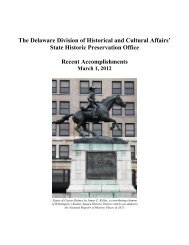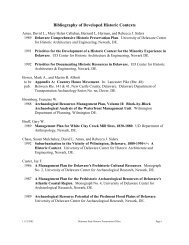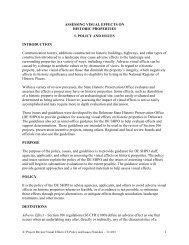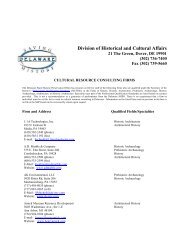Report of the Archaeological Investigations of the New Castle Court ...
Report of the Archaeological Investigations of the New Castle Court ...
Report of the Archaeological Investigations of the New Castle Court ...
Create successful ePaper yourself
Turn your PDF publications into a flip-book with our unique Google optimized e-Paper software.
NEW CASTLE COURT HOUSE PLAZA<br />
NEW CASTLE, DELAWARE<br />
4.0 ARTIFACT ANALYSIS<br />
activity. If viewed in terms <strong>of</strong> meals, Feature 20 yielded an assemblage that demonstrated a<br />
preference for large cuts <strong>of</strong> meat, frequently beef, chopped or split from <strong>the</strong> larger animal. Similar<br />
cuts were taken from sheep (leg <strong>of</strong> mutton), pig in <strong>the</strong> form <strong>of</strong> large hams, and even a small<br />
amount <strong>of</strong> venison. In spite <strong>of</strong> <strong>the</strong> late eighteenth-century date, <strong>the</strong>re was little wild food in <strong>the</strong><br />
assemblage. Even in early colonial settings, <strong>the</strong>re was a decided reliance on domestic mammals<br />
ra<strong>the</strong>r than wild game (Bowen 1998). This would have been even truer in established market<br />
villages or port towns.<br />
If not associated with a domestic occupation, this assemblage might be similar to that found in a<br />
tavern or public house. Many varieties <strong>of</strong> “public houses” served government <strong>of</strong>ficers and<br />
business communities in eighteenth and early nineteenth-century towns and government buildings<br />
were <strong>of</strong>ten associated with taverns or c<strong>of</strong>fee-houses (Rothschild 1990). In composition, faunal<br />
assemblages recovered from tavern sites were likely similar to residential and/or domestic meals.<br />
Cooking technology, likely open hearth, determined <strong>the</strong> type <strong>of</strong> meals. Large cuts <strong>of</strong> meat that<br />
could be boiled, braised or broiled were emphasized in both domestic and public settings.<br />
Although a variety <strong>of</strong> fowl and game might also have been served, <strong>the</strong> fragmented nature <strong>of</strong> <strong>the</strong><br />
<strong>Court</strong> House assemblages resulted in little archaeological evidence <strong>of</strong> diversity in diet and meals.<br />
4.2 CERAMIC AND GLASS ASSEMBLAGE FROM FEATURE 20<br />
Several fragments (n=5) <strong>of</strong> table glass were recovered from Feature 20 (Plate 18). Two <strong>of</strong> <strong>the</strong><br />
fragments are comprised <strong>of</strong> clear glass stems, while <strong>the</strong> remaining assemblage represents a<br />
drinking vessel or tumbler. The aqua colored glass tumbler exhibits a mold blown lozenge or<br />
bull’s eye shaped design (context 51). Following <strong>the</strong> typology presented by Noel Hume<br />
(1969:191) <strong>the</strong> remaining examples (derived from context 43) are quatrefoil stems where <strong>the</strong><br />
baluster is pinched into four segments (type VI, dated 1685-1705). Although not derived from<br />
Feature 20, a third stemware was recovered from nearby EU 7 (SU E, context 37); this vessel,<br />
although similar, appears to be a heavy inverted baluster with tear (type VII, dated 1690-1710).<br />
Two partial dark green bottles were recovered from Feature 20. Vessel 1 was composed <strong>of</strong> over a<br />
dozen mendable fragments (5 from context 43, 9 from context 153, and 1 from context 61) <strong>the</strong><br />
vessel exhibits a globular body with slightly rounded sides, gradually sloping shoulders, and a<br />
wide shallow kick (Plate 19). No bottle seal, neck or rim from <strong>the</strong> vessel was found and <strong>the</strong><br />
overall dimensions <strong>of</strong> <strong>the</strong> vessel are unknown. The bottle is best described as an onion bottle, a<br />
widely available bottle style that spans <strong>the</strong> decades <strong>of</strong> <strong>the</strong> 1680s through <strong>the</strong> 1730s (Dumbrell<br />
1983:56-67). Based on marked and dated examples provided by Dumbrell (1983:56, 62) <strong>the</strong><br />
physical characteristics <strong>of</strong> <strong>the</strong> Feature 20 onion bottle date it to <strong>the</strong> period circa 1699 to 1704.<br />
Examples <strong>of</strong> similar onion wine bottles housed in <strong>the</strong> Museum <strong>of</strong> London collection also<br />
reinforce a turn-<strong>of</strong>-<strong>the</strong>-seventeenth century date range (Museum <strong>of</strong> London n.d.). The second<br />
vessel consists <strong>of</strong> three sherds from context 147, two <strong>of</strong> which mend at <strong>the</strong> base (Plate 18). The<br />
wall thickness is thinner than <strong>the</strong> previous example, but a similar shallow kick is evident. Overall<br />
bottle form is unknown, although it may represent a second onion bottle.<br />
Fragments from <strong>the</strong> neck and rim <strong>of</strong> a gray Westerwald stoneware vessel (n=4) mended between<br />
Feature 20 (contexts 43 and 44) and SU E within units 9 and 23 (contexts 62 and146). The rim<br />
diameter measures 2.5 in. and a partial handle extends from <strong>the</strong> neck (Plate 20). A slight flaring<br />
<strong>of</strong> <strong>the</strong> sides <strong>of</strong> <strong>the</strong> vessel indicates that its form is that <strong>of</strong> jug not a mug. The body is decorated<br />
with blue cobalt, incised lines, and medallions. No body or basal sherds were recovered for this<br />
vessel, so its overall dimensions remain unknown.<br />
62









